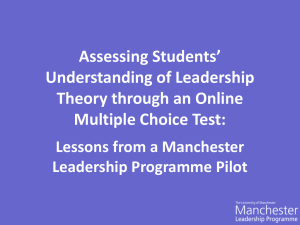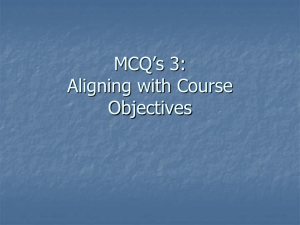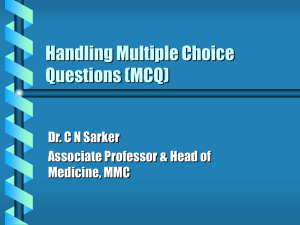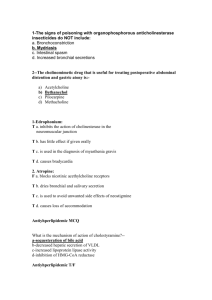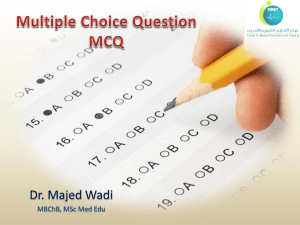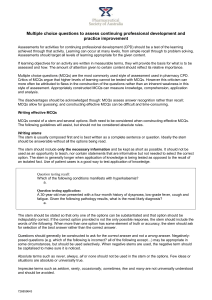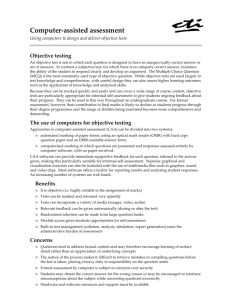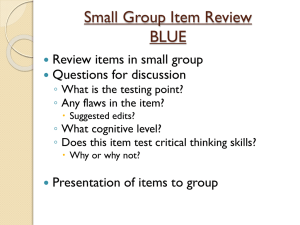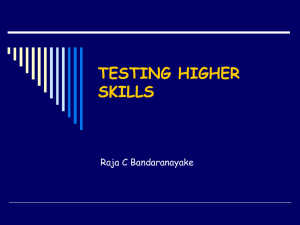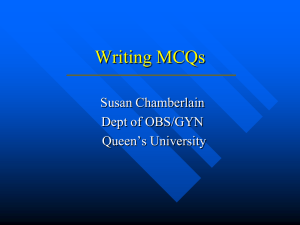MCQs 1 - Construction
advertisement
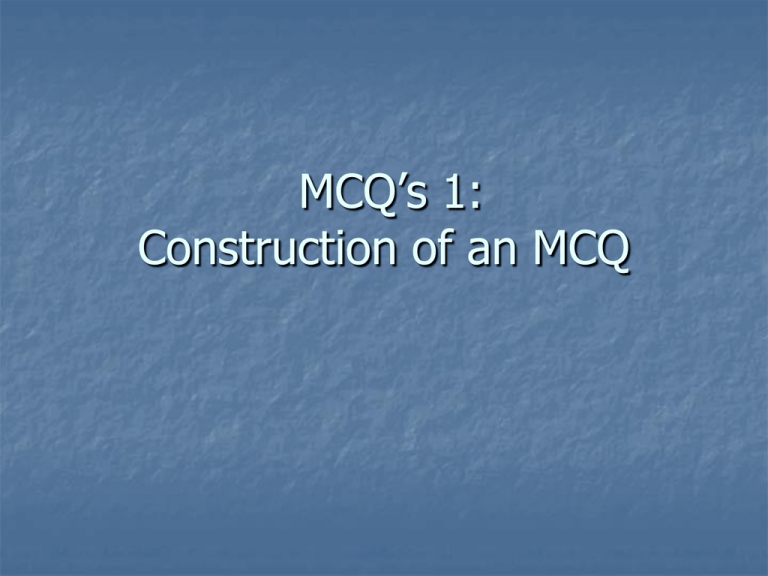
MCQ’s 1: Construction of an MCQ MCQ Check-list This presentation will focus on: Why we write them What type is best What flaws are to be avoided What content to test How to construct it Why do we test? Formative assessment Summative assessment Communicate to the students what material is important Identify areas of deficiency in need of remediation or further learning Determine final grades Make promotion decisions Both Motivate students to study Identify areas where the course/curriculum is weak What Should Be Tested? Exam content should match course objectives Important topics should be weighted more heavily than less important topics The testing time devoted to each topic should reflect the relative importance of the topics What Should Be Tested? Sampling - Performance on the sample provides a basis for estimating achievement in the broader domain that is actually of interest Questions sample: TOPICS – eg MCC presentations SKILLS – eg Course Objectives – determining diagnosis, next step in management, etc. Anatomy of an MCQ Item Stem Lead-in Options One correct answer Distractors Types of MCQ’s True/False family Assess recall of isolated facts Stems must be clear and unambiguous Options must be absolutely true or false or examinee must decide how true options are Generally not recommended – usually have subtle flaws Types of MCQ’s: True/False Which of the following statements is true regarding contraception? A) B) C) D) E) oral contraceptives should not be initiated until six weeks after therapeutic abortion to avoid the risk of hypercoagulability an intrauterine device can provide good contraceptive protection 5 years after insertion oral contraceptives should not be prescribed to individuals under the age of 15 without parental consent lesbian women do not require counseling about contraception or sexually transmitted diseases oral contraceptives should not be prescribed for women over the age of 35 Types of MCQ’s One-Best-Answer family (A type) Options may be diagrammed: D C A Least correct E B Most correct Correct answer is the most likely correct Better application of knowledge, integration, synthesis and judgment Types of MCQ’s: One-Best-Answer family A 24 year old university student came to see you because she is missing several days of school each month because of severe dysmenorrhea unresponsive to the OCP and NSAIDS. She also complains of deep dyspareunia and has a tender uterosacral nodule on pelvic examination. Which one of the following conditions is most likely responsible for her symptoms? A) B) C) D) Chronic pelvic inflammatory disease Endometriosis Adenomyosis Fibroids What to test? Items can be classified by cognitive processes required to answer the question: Recall (Memory)– tests knowledge of isolated facts Interpretation (Comprehension)– review information to reach conclusion, eg diagnosis Problem solving (Reasoning) – situation requires action, eg next step in management Process depends on background of trainee What to test? Simpler classification based on task: Application of knowledge item ** Reach conclusions Make predictions Select course of action Recall item Test knowledge of isolated facts What to test? Test application of knowledge using clinical vignettes Adds ‘face-validity’ Usually selects more important, less trivial Identifies student who’ve memorized but do not understand BUT experience in patient care should not be necessary What to test - summary Focus item on key concepts and principles that are essential information (without access to references) for all examinees to understand Test material that is relevant to learning in preclinical courses and beyond Avoid items that only require recall of isolated facts Avoid esoteric or interesting topics that are not essential What to test - summary Test application of knowledge using clinical vignettes to pose medical decisions in patient care situations Focus items on common or potentially catastrophic problems Pose clinical decisions that would be expected of a successful examinee ie Avoid clinical situations that would be handled by a (sub)specialist Anatomy of an MCQ Item Stem Lead-in Options One correct answer Distractors Writing the Questions Construct stem –include all necessary information to arrive at the right answer Choose lead-in – pose a clear question Choose distractors Stem* Usually a clinical scenario Clear, unambiguous Should be long relative to options Includes all pertinent information Patient’s age/gender Clinical setting Complaint Other important info – history, physical findings, test results Lead-in* Follows stem In the form of a question Should relate to the stem Should be answerable without looking at options “Cover the Options test” Should clearly communicate the learning objective Distractors Each should be selected by some, therefore all plausible, none obviously incorrect 3 or 4 choices Common misconceptions Faulty reasoning Distractors Homogeneous in content to the correct answer Should be in same category as correct answer– diagnosis, treatment, diagnostic test Clearly incorrect or inferior to the correct answer Plausible and attractive to the uninformed Similar to the correct answer in construction and length Grammatically consistent and logically compatible with the stem General Guidelines for Item Construction Include as much of the item as possible in the stems: Long stems, short options Avoid negatively phrased items (except or not in the lead-in). If you must, use only with short options Avoid writing questions of the form: Which of the following statements is correct? Each of the following statements is correct EXCEPT Unfocussed Heterogeneous options “Top-down” versus “Bottom-up” Top-Down Knowledge or recall question Cite a disease and then ask what patient findings are expected Structured like textbooks Clinically backward “Top-down” versus “Bottom-up” Bottom-up Application of knowledge Gives findings and asks examinee to indicate the disease Examinees need to be able to synthesize information from several pages of a textbook (or notes) to answer these questions Clinically realistic Basic Rules for MCQ’s (A type)* Focus item on important concept Item should assess application of knowledge, not recall of an isolated fact Stem must pose clear question – ‘Cover the options’ test All distractors should be homogeneous Avoid technical item flaws Reference Constructing Written Test Questions For the Basic and Clinical Sciences Case & Swanson, NBME 1996 Basic Rules for MCQ’s (A type)* Focus item on important concept Item should assess application of knowledge, not recall of an isolated fact Stem must pose clear question – ‘Cover the options’ test All distractors should be homogeneous Avoid technical item flaws One last step… Get a colleague to read over your questions Detects more than one right answer Discovers the ‘what am I thinking?’ question Identifies not enough information in the stem …
